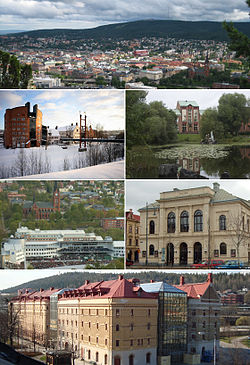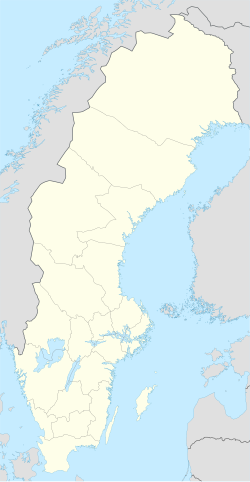Sundsvall
You can help expand this article with text translated from the corresponding article in Swedish. (March 2020) Click [show] for important translation instructions.
|
Sundsvall | |
|---|---|
 Top: Panorama view of downtown Sundsvall, Stenstaden and South Stadsberget, 2nd left: Mid Sweden University (Mittuniversitetet), 2nd right: Court of Appeal for Lower Norrland in Bunsouska Pond, 3rd left: North Gate Arena and Gustav Adolf Church, 3rd right: Sundsvall Theater, Bottom: Kulturmagasinet, Sundsvall Museum and Library | |
| Coordinates: 62°24′N 17°19′E / 62.400°N 17.317°E | |
| Country | Sweden |
| Province | Medelpad |
| County | Västernorrland County |
| Municipality | Sundsvall Municipality |
| Area | |
• City | 27.46 km2 (10.60 sq mi) |
| Population (31 December 2020)[2] | |
• City | 58,807 |
| • Density | 1,847/km2 (4,780/sq mi) |
| • Urban | 99,825 |
| Time zone | UTC+1 (CET) |
| • Summer (DST) | UTC+2 (CEST) |
Sundsvall (Swedish: [ˈsɵ̂nː(d)sval] ⓘ)[3] is a city and the seat of Sundsvall Municipality in Västernorrland County, Sweden. It has a population of 58,807 as of 2020; more than 95,000 live in the municipal area. It is Sweden's 21st largest city by population. Old town in Sundsvall is known as Stenstan, meaning stone city referencing the stone buildings from the late eighteen hundreds.
History
[redakti]
The town was chartered in 1621, and a first urban plan for Sundsvall was probably created by Olof Bure in 1642, less likely in 1623.[4] It has a port by the Gulf of Bothnia, and is located 395 km north of Stockholm. The city has burned down and been rebuilt four times.[5] The first time, in 1721, it was set on fire by the Russian army during the Russian Pillage of 1719-1721.

According to one historian,[who?] Swedish industrialism started in Sundsvall when the Tunadal sawmill bought a steam-engine driven saw in 1849. In the early 20th century Sundsvall was an even greater centre of forestry industry in Sweden than it is today. The first large Swedish strike was the "Sundsvall strike" in 1879.[7] The industrial heritage makes social democrat and socialist sympathies more prevalent in the Sundsvall region than in Sweden as a whole.
In 1888 on 25 June, strong wind and dry conditions contributed to two city fires in Sweden on the same day. On this day both Umeå and Sundsvall caught fire.[6] The Sundsvall fire was the largest in Sweden's history. It is presumed that the fire was caused by a spark from a steamship. After the fire, and unlike Umeå, the decision was to rebuild using stone. Sundsvall's centre was later nicknamed Stenstaden (the stone city). One advantage of the new construction was that within three years the town was arguing that it should be allowed reduced insurance as new rules had been brought in that applied to wooden towns. One disadvantage was that after the fire only the better off could afford to live in the centre.[8]
Today Sundsvall is not only dominated by the pulp and paper industry, and the aluminium production but there are also banks, insurance companies, telecommunications administration and a number of large public data-processing centres such as the national social insurance board. The main campus of the Mid Sweden University (Mittuniversitetet) is also located in the city. The university, established in 1993, is a collaboration between Östersund, Sundsvall and Härnösand.

Demography
[redakti]| Year | Pop. | ±% |
|---|---|---|
| 1621 | 35 | — |
| 1721 | 500 | +1328.6% |
| 1810 | 1,485 | +197.0% |
| 1850 | 2,837 | +91.0% |
| 1885 | 10,275 | +262.2% |
| 1910 | 16,854 | +64.0% |
| 1930 | 18,007 | +6.8% |
| 1940 | 18,852 | +4.7% |
| 1950 | 25,706 | +36.4% |
| 1960 | 29,419 | +14.4% |
| 1965 | 58,704 | +99.5% |
| 1970 | 64,920 | +10.6% |
| 1974 | 92,483 | +42.5% |
| 2004 | 93,707 | +1.3% |
| 2005 | 94,044 | +0.4% |
| Source: Census data | ||
Culture
[redakti]During 1987–2013, there was a summer music festival called Gatufesten. Starting in 2014 there's a new one called Hamnyran. There are two theatres and various musical venues. There is also a small guitar festival and a larger heavy metal festival every autumn called Nordfest.[9] Sundsvall is also home to the unique festival Musikschlaget,[10] which is a song contest for groups around Sweden with disabilities.
Transport
[redakti]Its airport is Sundsvall-Timrå Airport, also called Midlanda.
Sport
[redakti]
- Alnö IF, association football
- GIF Sundsvall, association football
- IF Sundsvall Hockey, ice hockey
- IFK Sundsvall, association football
- Sundsvalls AIK (sv), wrestling (https://www.sundsvallsaik.se/)
- Sundsvalls DFF, association football
- Kovlands IF, multi-sport alliance club
- Kovlands Ishockeyförening, ice hockey
- Selånger SK, multi-sport alliance club
- Selånger FK, association football
- Selånger SK Bandy, bandy
- Sidsjö-Böle IF, association football
- Sund IF, association football
- Sundsvall Dragons, basketball
- Sundsvall Flames, American football
- Njurunda MK, Motocross, Enduro and Trial
Former
[redakti]- IBK Sundsvall, floorball (1986–2006)
Notable people
[redakti]- Otto Wallin, boxer
- Garmarna, folk band
- The Same, punk band
- Sigrid Hjertén (1885–1948), painter
- Harry Ahlin (1900–1969), actor
- Per Arne Collinder (1890–1975), astronomer (born in Sundsvall)
- Gina Dirawi (1990–), television presenter, host of Melodifestivalen 2012 and 2013
- Elin Ek (1976–), TV and radio personality (as Grynet), singer
- Fredrik Ericsson (1975–2010), extreme skier
- Jessica Falk (1973–), singer-songwriter and musician
- Anders Abraham Grafström (1790–1870), poet
- Anders Graneheim (1962–), bodybuilder
- Stan Hasselgård (1922–1948), musician
- Bengt Lindström (1925–2008), artist
- Kjell Lönnå (1936–2022), musician
- Fredrik Modin (1974–), ice hockey player
- Max Magnus Norman (1973–), artist
- Daniel Ohrn (1993-), ice hockey player
- Erik Ringmar (1960–), political scientist and author
- Mattias Saari (1994–), ice hockey player
- Helen Sjöholm (1970–), singer, actress and musical theater performer
- Hanna Glas (1993–), football player
- Carl Strandlund (1899–1974), Swedish-American inventor and entrepreneur
- Henrik Zetterberg (1980–), ice hockey player
- Yohio (1995–), singer and guitarist
- Kevin Walker (1989–), football player and winner of Idol 2013
- Charlotte Kalla (1987–), cross-country skier
- Carl-Herman Tillhagen (1906~2002), folklorist
- Emil Forsberg (1991–), football player
- Elias Pettersson (1998–), ice hockey player and 2019 Calder Trophy winner
- MyAnna Buring (1979–), actress (born in Sundsvall)
- Ursula Wirth (1934–2019), rally driver
Gallery
[redakti]
|

|

|
| Sundsvall viewed from above | Sundsvall City Centre | Gustav Adolfskyrkan |
Climate
[redakti]Sundsvall has a climate which is on the border between subarctic (Dfc) and cold humid continental (Dfb), leaning towards the latter in recent years. Temperatures are made significantly milder and regulated by the influence from the Gulf Stream. The weather station is located 20 kilometres (12 mi) to the north and somewhat further inland near Timrå, which renders that Sundsvall's urban centre is likely milder in terms of low temperatures by some degree.
| Climate data for Sundsvall Airport (2002–2021); extremes since 1943; sunshine[11] 1961–1990 | |||||||||||||
|---|---|---|---|---|---|---|---|---|---|---|---|---|---|
| Month | Jan | Feb | Mar | Apr | May | Jun | Jul | Aug | Sep | Oct | Nov | Dec | Year |
| Record high °C (°F) | 11.0 (51.8) |
13.8 (56.8) |
15.2 (59.4) |
21.9 (71.4) |
27.4 (81.3) |
35.0 (95.0) |
33.0 (91.4) |
31.3 (88.3) |
27.2 (81.0) |
21.5 (70.7) |
14.0 (57.2) |
10.5 (50.9) |
35.0 (95.0) |
| Mean maximum °C (°F) | 5.3 (41.5) |
6.8 (44.2) |
11.5 (52.7) |
16.8 (62.2) |
22.2 (72.0) |
25.7 (78.3) |
27.8 (82.0) |
26.0 (78.8) |
21.1 (70.0) |
14.5 (58.1) |
8.8 (47.8) |
6.7 (44.1) |
28.8 (83.8) |
| Mean daily maximum °C (°F) | −2.5 (27.5) |
−1.2 (29.8) |
3.3 (37.9) |
8.6 (47.5) |
14.0 (57.2) |
18.8 (65.8) |
21.7 (71.1) |
20.0 (68.0) |
15.3 (59.5) |
8.3 (46.9) |
2.6 (36.7) |
−0.6 (30.9) |
9.0 (48.2) |
| Daily mean °C (°F) | −6.5 (20.3) |
−5.6 (21.9) |
−1.4 (29.5) |
3.5 (38.3) |
8.6 (47.5) |
13.5 (56.3) |
16.7 (62.1) |
15.6 (60.1) |
10.8 (51.4) |
4.6 (40.3) |
−0.4 (31.3) |
−4.1 (24.6) |
4.6 (40.3) |
| Mean daily minimum °C (°F) | −10.4 (13.3) |
−10.0 (14.0) |
−6.1 (21.0) |
−1.7 (28.9) |
3.2 (37.8) |
8.2 (46.8) |
11.7 (53.1) |
10.6 (51.1) |
6.2 (43.2) |
0.8 (33.4) |
−3.4 (25.9) |
−7.6 (18.3) |
0.1 (32.2) |
| Mean minimum °C (°F) | −22.5 (−8.5) |
−21.5 (−6.7) |
−17.4 (0.7) |
−7.4 (18.7) |
−3.0 (26.6) |
2.3 (36.1) |
6.1 (43.0) |
4.5 (40.1) |
−0.1 (31.8) |
−6.4 (20.5) |
−11.5 (11.3) |
−16.8 (1.8) |
−24.9 (−12.8) |
| Record low °C (°F) | −35.5 (−31.9) |
−34.8 (−30.6) |
−34.2 (−29.6) |
−20.0 (−4.0) |
−8.2 (17.2) |
−2.0 (28.4) |
1.9 (35.4) |
−0.6 (30.9) |
−7.7 (18.1) |
−15.2 (4.6) |
−22.1 (−7.8) |
−36.6 (−33.9) |
−36.6 (−33.9) |
| Average precipitation mm (inches) | 56.1 (2.21) |
31.7 (1.25) |
30.5 (1.20) |
27.6 (1.09) |
43.3 (1.70) |
46.9 (1.85) |
58.8 (2.31) |
72.5 (2.85) |
59.6 (2.35) |
63.6 (2.50) |
51.0 (2.01) |
59.1 (2.33) |
600.7 (23.65) |
| Average extreme snow depth cm (inches) | 38 (15) |
45 (18) |
43 (17) |
23 (9.1) |
0 (0) |
0 (0) |
0 (0) |
0 (0) |
0 (0) |
0 (0) |
9 (3.5) |
22 (8.7) |
52 (20) |
| Mean monthly sunshine hours | 43 | 81 | 135 | 185 | 259 | 287 | 267 | 215 | 142 | 98 | 57 | 34 | 1,803 |
| Source 1: SMHI Open Data for Sundsvall-Timrå flygplats, temperature[12] | |||||||||||||
| Source 2: SMHI Open Data for Stordala-Midlanda D, precipitation[13] | |||||||||||||
References
[redakti]- ^ "Tätorternas landareal, folkmängd och invånare per km2 2005 och 2010" (in Swedish). Statistics Sweden. 14 December 2011. Archived from the original on 27 January 2012. Retrieved 10 January 2012.
- ^ "Statistiska tätorter 2018, befolkning, landareal, befolkningstäthet per tätort" (in Swedish). Statistics Sweden. 23 March 2021. Retrieved 23 March 2021.
- ^ Jöran Sahlgren; Gösta Bergman (1979). Svenska ortnamn med uttalsuppgifter (in Swedish). p. 23.
- ^ Nils Ahlberg, Stadsgrundningar och planförändringar : Svensk stadsplanering 1521–1721 Archived 14 August 2011 at the Wayback Machine, avhandling vid Institutionen för landskapsplanering Ultuna och Konstvetenskapliga institutionen, Stockholms universitet 2005, s. 550
- ^ "Lokal historia". Archived from the original on 3 May 2009. Retrieved 2 March 2009.
- ^ a b Fire of 1888 Archived 29 May 2014 at the Wayback Machine, Sunsvall.se, retrieved 28 May 2014
- ^ http://www.popularhistoria.se/o.o.i.s?id=43&vid=612[permanent dead link]
- ^ Rohland, Eleonora (1 February 2011). "From Wood to Stone: The Risk Management of Swiss Re in The Sundsvall Fire 1888". Environment and History. 17 (1): 153–169. doi:10.3197/096734011X12922359173096. Retrieved 29 May 2014.
- ^ "Nordfest". www.nordfest.se. Archived from the original on 20 August 2017. Retrieved 20 August 2017.
- ^ "www.musikschlaget.se". www.musikschlaget.se. Archived from the original on 11 September 2017. Retrieved 20 August 2017.
- ^ "NOAA WMO Normals 1691–1990". National Oceanic & Atmospheric Administration.
- ^ "SMHI Open Data for Sundsvall-Timrå flygplats, temperature" (in Swedish). Swedish Meteorological and Hydrological Institute. Retrieved 10 May 2022.
- ^ "SMHI Open Data for Stordala-Midlanda D, precipitation" (in Swedish). SMHI. Retrieved 10 May 2022.
External links
[redakti]- Sundsvall – Official site
- (in Swedish) article Sundsvall from Nordisk Familjebok (1918)
- (in Swedish) sundsvallturism.com – Sundsvalls tourist information bureau.
- (in English) Sundsvalltown.se – The alternative guide to Sundsvall.
- (in Swedish) sundsvallsbilder.com – Blog with photos from Sundsvall.




